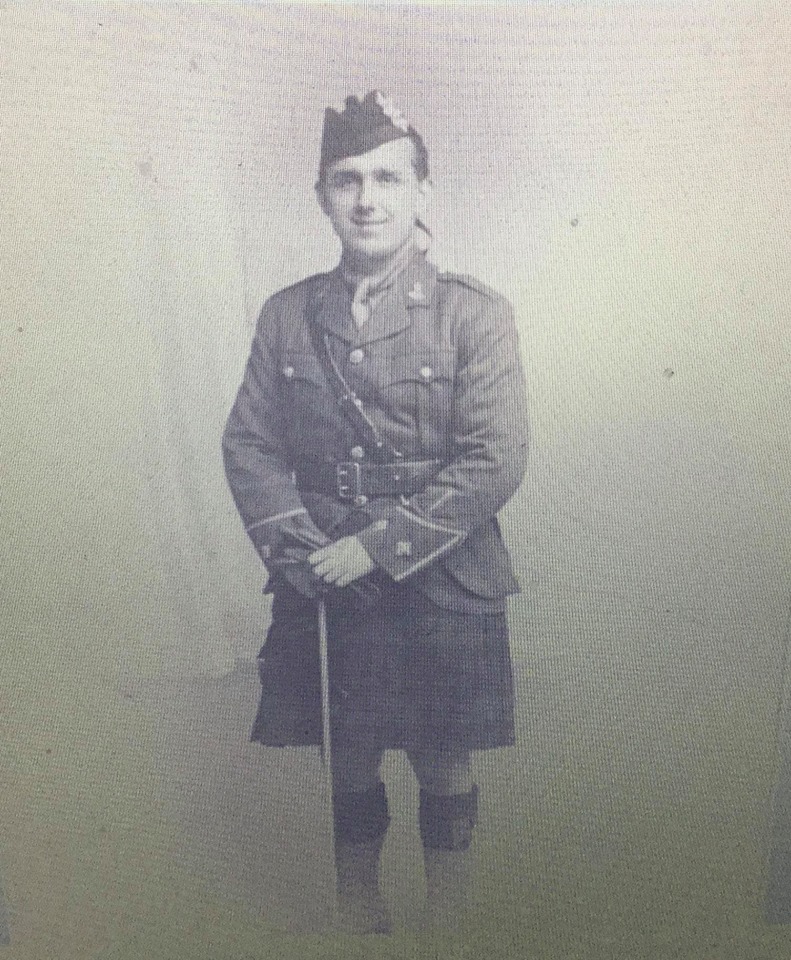Captain Andrew Allan Macartney 24735 was born 4 January 1891 in Glasgow, Scotland. He enlisted 23 September 1914 at Valcartier, Quebec, with the Royal Highlanders of Canada (R.H.C.). Andrew had two years prior service with R.H.C. His mother, Mrs S. Macartney resided at Brighton Cottage, Duncan, Scotland. He was married to Agnes Macartney. He was a clerk, and stood 5′ 6″ tall, with dark complexion, hazel eyes, and black hair.
Andrew served with the 13th Battalion, R.H.C., 17th Reserve Battalion, 92nd Battalion, 9th Reserve Battalion, 20th Reserve Battalion, 1st Q.H.D., Canadian Training School (CTS), Canadian Discharge Depot (CDD), and became the Director of Records Staff in London during demobilization. He rose from Private to Captain during his remarkable career. Andrew was among the very last of the CEF to return to Canada in 1919.
Andrew’s brother, John David Macartney 157633 served with the 18th Battalion, in 1916. He was wounded twice, and transferred to the C.A.M.C. in October of 1916. From then, John spent the remaining of the war in England and had the opportunity to be with his brother many times.
Service
On 25 August 1914, Andrew Allan Macartney now shown on No. 3 Coy., 13th Battalion pay lists. He soon sailed on 3 October 1914. Appointed Lance Corporal, 9 November 1914. Then, promoted to Corporal, 27 January 1915, Lark Hill. Subsequently, admitted 2nd South General Hospital, Bristol, sprained right ankle, 27 April 1915. Then, discharged to furlough, 25 May 1915. Finally, on 30 July 1915, attached to Chief Paymaster Office on Command, Shorncliffe.
First Gold Stripe
Second Battle of Ypres, the first gas-attacks, began on 22 April 1915. Later, on 24 April 1915, working on the trenches in St. Julien, Andrew Allan Macartney is slightly wounded by shrapnel in the ankle. He has a long recovery, for a light wound. Eventually, he reports back to duty with his unit on 30 June 1915.
Admitted Barnwell Military Hospital, Cambridge, 6 January 1916. Discharged 24 February 1916. Then, on 17 April 1916, transferred to 73rd Battalion, East Sandling. Finally, Taken-on-Strength (T.o.S.) 17th Battalion, 11 May 1916.

To be A/Sergeant, 8 June 1916, London. Transferred to 92nd Battalion, 19 July 1916. Later, on 24 October 1916 in East Sandling, he returned to unit as Corporal, with view to taking up a Commission.
On 25 November, On Command, C.M.S., Crowborough. Then, on 7 December 1916, returns to 92nd Battalion, awaiting Commission. Later, on 14 March 1917, he is appointed T/Lieutenant. Then, he proceeded overseas to 13th Battalion, arriving Le Havre, 22 April 1917. Finally, he joined his unit 28 April 1917.
Second Gold Stripe
During the opening day of the Battle of Hill 70, Lieutenant Macartney is wounded. Admitted No. 1 C.C.S. 15 August 1917. On 16 August 1917, reported from base, wounded. GSW right wrist. Admitted No. 7 Canadian General Hospital, St. Omer, 16 August 1917, GSW right wrist, severed tendons.

Invalided to England per A.T. ST ANDREW, 19 August 1917. Then, reported serious, admitted 20 August 1917, 1st East General Hospital, Cambridge. Later, on 19 October 1917, Andrew is discharged. Once again, Andrew’s recovery is slow. It is months before he regains proper use of his hand.
Canadian Training School
To be Assistant Instructor at Canadian Training School, Bexhill, 20 May 1918. The Canadians had arrived in Bexhill on 12 March 1917 following the relocation of the CTS from Crowborough, and had moved to Camp Cooden by the time Andrew arrived.
The Canadians took over many of the town centre buildings. Egerton Park was the main training grounds. In addition, land where St. Augustine’s Church now stands, is where the Warfare School laid trenches. Further, Down Council School (now King Offa School) hosted lectures. The Metropole Hotel housed the main billets. Finally, The Sackville Hotel, The Pelham Hotel, the Kursaal, and Bexhill Museum were used for entertainment.

Lieutenant General Sir R. E. W. Turner often visited the camp. Andrew was very close by, and perhaps is captured in some of these photos. However, these photos are not captured by the Canadian Official War Photographer. Lieutenant William Rider-Rider is on assignment on the Western Front.

Camp Cooden has been a residential development since the 1960’s. Today, the preeminent expert on Canadians at Bexhill is Dr Luke Flanagan.
Demobilization
Firstly, ceases to be Assistant Instructor at G.T.S., 9 December 1918, and attached to permanent cadre for instruction in demobilization, Buxton. Shortly thereafter, on 14 December 1918, Andrew ceases to be attached on proceeding to Rhyl.
Then, on 18 February 1919, T.o.S. staff of O/S Representative Director of Records, M.H.Q., C.E.F., Buxton, on transfer from O.M.F.C. Shortly thereafter, S.o.S. of O.M.F.C. on being transferred to staff M.H.Q., C.E.F., Kinmel Park Camp, Rhyl, England.

Subsequently, promoted to A/Rank of A/Captain, retroactive to 21 December 1918 (London Gazette, No.301524, 27 August 1919). After that, Captain Andrew Allan Macartney is S.o.S. as Overseas Representative Director of Records, M.H.Q. Finally, being returned to Canada for disposal of Adjutant General, 20 September 1919, London, England.
Captain Andrew Allan Macartney arrived aboard MINNEDOSA, Quebec, 10 October 1919. He may have been the very last of the C.E.F. to return to Canada. He is S.o.S. as A/Captain, 14 October 1919.
More
For more information about the Canadians in Brexhill, CEFRG suggests you visit Dr. Luke Flanagan’s website Canadians in Bexhill.

More
Please subscribe to CEFRG to be notified by email when there are new posts. Subscription is free, and your email kept confidential.
